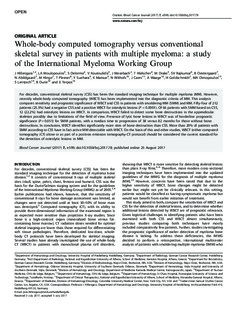| dc.contributor.author | Hillengass, J | |
| dc.contributor.author | Moulopoulos, LA | |
| dc.contributor.author | Delorme, S | |
| dc.contributor.author | Koutoulidis, V | |
| dc.contributor.author | Mosebach, J | |
| dc.contributor.author | Hielscher, T | |
| dc.contributor.author | Drake, M. | |
| dc.contributor.author | Rajkumar, SV | |
| dc.contributor.author | Oestergaard, B | |
| dc.contributor.author | Abildgaard, N | |
| dc.contributor.author | Hinge, M | |
| dc.contributor.author | Plesner, T | |
| dc.contributor.author | Suehara, Y | |
| dc.contributor.author | Matsue, K | |
| dc.contributor.author | Withofs, N | |
| dc.contributor.author | Caers, J | |
| dc.contributor.author | Waage, Anders | |
| dc.contributor.author | Goldschmidt, H | |
| dc.contributor.author | Dimopoulos, MA | |
| dc.contributor.author | Lentzsch, S | |
| dc.contributor.author | Durie, B | |
| dc.contributor.author | Terpos, E | |
| dc.date.accessioned | 2018-06-28T08:04:29Z | |
| dc.date.available | 2018-06-28T08:04:29Z | |
| dc.date.created | 2017-10-24T10:51:45Z | |
| dc.date.issued | 2017 | |
| dc.identifier.citation | Blood Cancer Journal. 2017, 7(8). | nb_NO |
| dc.identifier.issn | 2044-5385 | |
| dc.identifier.uri | http://hdl.handle.net/11250/2503465 | |
| dc.description.abstract | For decades, conventional skeletal survey (CSS) has been the standard imaging technique for multiple myeloma (MM). However, recently whole-body computed tomography (WBCT) has been implemented into the diagnostic criteria of MM. This analysis compares sensitivity and prognostic significance of WBCT and CSS in patients with smoldering MM (SMM) and MM. Fifty-four of 212 patients (25.5%) had a negative CSS and a positive WBCT for osteolytic lesions (P<0.0001). Of 66 patients with SMM based on CSS, 12 (22.2%) had osteolytic lesions on WBCT. In comparison, WBCT failed to detect some bone destructions in the appendicular skeleton possibly due to limitations of the field of view. Presence of lytic bone lesions in WBCT was of borderline prognostic significance (P=0.051) for SMM patients, with a median time to progression of 38 versus 82 months for those without bone destructions. In conclusion, WBCT identifies significantly more sites of bone destruction than CSS. More than 20% of patients with SMM according to CSS have in fact active MM detectable with WBCT. On the basis of this and other studies, WBCT (either computed tomography (CT) alone or as part of a positron emission tomography-CT protocol) should be considered the current standard for the detection of osteolytic lesions in MM. | nb_NO |
| dc.language.iso | eng | nb_NO |
| dc.publisher | Nature Publishing Group | nb_NO |
| dc.rights | Navngivelse 4.0 Internasjonal | * |
| dc.rights.uri | http://creativecommons.org/licenses/by/4.0/deed.no | * |
| dc.title | Whole-body computed tomography versus conventional skeletal survey in patients with multiple myeloma: A study of the International Myeloma Working Group | nb_NO |
| dc.type | Journal article | nb_NO |
| dc.type | Peer reviewed | nb_NO |
| dc.description.version | publishedVersion | nb_NO |
| dc.source.volume | 7 | nb_NO |
| dc.source.journal | Blood Cancer Journal | nb_NO |
| dc.source.issue | 8 | nb_NO |
| dc.identifier.doi | 10.1038/bcj.2017.78 | |
| dc.identifier.cristin | 1507145 | |
| dc.description.localcode | © The Author(s) 2017. This work is licensed under a Creative Commons Attribution 4.0 International License. The images or other third party material in this article are included in the article’s Creative Commons license, unless indicated otherwise in the credit line; if the material is not included under the Creative Commons license, users will need to obtain permission from the license holder to reproduce the material. To view a copy of this license, visit http://creativecommons.org/licenses/ by/4.0/. | nb_NO |
| cristin.unitcode | 194,65,15,0 | |
| cristin.unitname | Institutt for klinisk og molekylær medisin | |
| cristin.ispublished | true | |
| cristin.fulltext | original | |
| cristin.qualitycode | 1 | |

